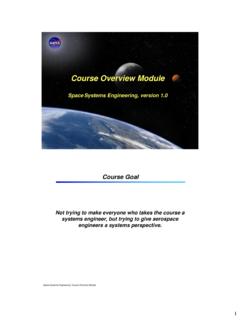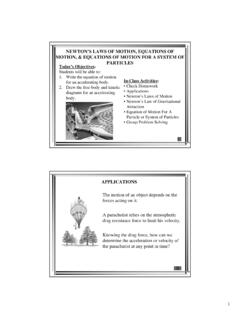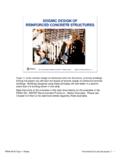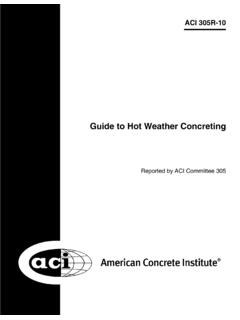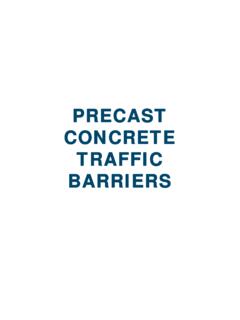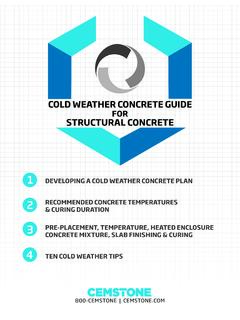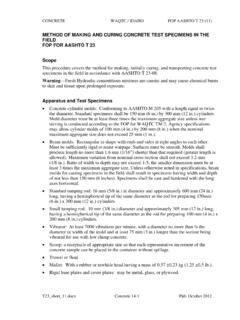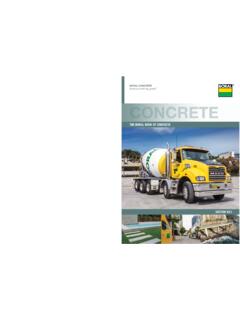Transcription of Reinforced Concrete Beam - California State University ...
1 1 jkmMechanics of MaterialsMechanics of MaterialsReinforced Concrete BeamReinforced Concrete BeamConcrete Beam2 jkmConcrete BeamConcrete beam We will examine a Concrete beam in bending A Concrete beam is what we call a composite beam It is made of two materials: Concrete and steel Concrete is also a composite2P2P2 Concrete Beam3 jkmConcrete beam TestConcrete beam Test Loading Maximum Moment is in the center region2P 2PV12 PLML1L12PL2P2P2 PConcrete Beam4 jkmConcrete StrengthConcrete Strength We determine the compressive strength of Concrete with a Concrete cylinder test Cylinders are typically 6 inches in diameter 12 inches long We want the stress-strain results so we measure load and change in length3 Concrete Beam5 jkmConcrete Cylinder TestConcrete Cylinder TestConcrete Beam6 jkmConcrete Stress StrainConcrete Stress Strain The
2 Concrete stress-strain diagram is not linearstressstrainf c2fc'4 Concrete Beam7 jkmCompositeComposite When we examine a beam we generally need a value of Eto use in the analysis Do we use E for Concrete or steel? We will usually pretend that the beam is made of only one material, usually Concrete We Transform the steel to an equivalent amount of Concrete How much Concrete do we substitute for the steel? Concrete Beam8 jkmModular RatioModular Ratio Which is stiffer, steel or Concrete ? Esfor steelis about 29,000 ksi Ecfor concreteis about 3 to 6,000 ksi, and will be different for every batch of Concrete We get Ecfrom the cylinder tests Let s define n to be the modular ratioCsEEn It tells you how much stiffer steel is compared to concrete5 Concrete Beam9 jkmModulus of ConcreteModulus of Concrete --EEcc The Concrete stress-strain diagram is not linearstressstrainf c2fc'Ec Ecis the slope of the stress-strain curve up to about half the strength of the concreteDo a regression through these pointsConcrete Beam10 jkmSteel is StifferSteel is Stiffer Since the steel is stiffer than the Concrete .
3 When we replace the steel with Concrete , we will need more Concrete to make it equivalent How much more? We will multiply the amount of steel by n to get the equivalent amount of concretessA' nA Asis the total cross sectional area of the steel for all the bars6 Concrete Beam11 jkmTransformed SectionTransformed Section When we replace the steel with equivalent Concrete , we have effectively transformed everything to Concrete We call the resulting all Concrete beam the Transformed Section Let s examine the process .. Concrete Beam12 jkmEquivalent SteelEquivalent Steel ReplaceAsbyAs As =nAstotalAs=total area of steelAs=total area of steelThis concretenow models the steelSAn)1( As =(n-1) Asafter filling holes 7 Concrete Beam13 jkmNeutral AxisNeutral Axis The NA passes through the centroid,the balance point The moment of the area above the NA is the same as the moment of the area below the NA (both the real Concrete and the equivalent Concrete )Assume this height is smallNASAn)
4 1( * Concrete Beam14 jkmTransformed SectionTransformed Section We want to find the Itrof our transformed section about the NA The section is composed of three parts We first need to locate the NANASAn)1( The part above the NA The portion below the NA And the transformed area, (n-1)As8 Concrete Beam15 jkmNeutral AxisNeutral Axis Locate the NA Solve for ctr This locates the NA (1)22 trtrtrtrstrhccbcb h cn A d cNActrhbdAbove NABelow NATransformed steelSAn)1( Concrete Beam16 jkmIItr tr of the Transformed Sectionof the Transformed Section Find Itr Solve for Itr 332(1)33 trtrtrstrbh cbcInAdc2cgAdII NActrhbdParallel axis theoremTop, compression concreteBottom, Tension concreteSteel transformed into concreteSAn)1( 9 Concrete Beam17 jkmCracksCracks What happens to the tension Concrete as the load get higher and higher?)
5 It starts to crack,first at the bottom As the load increases, the cracks progress higherand higher Finally, all the Concrete in tension will crack Once the tension Concrete cracks, it cannot hold tension stressesNASnAConcrete Beam18 jkmCracked SectionCracked Section We call the resulting section with all the Concrete below the NA cracked, thecracked section Now we effectively have only two remaining areas,because the Concrete below the NA is cracked We must find the new location of the NANASnA10 Concrete Beam19 jkmCracked Section NACracked Section NA Since there is less Concrete toward the bottom, the NA will move up Calculate the new centroidto locate the NA 2crcrscrcbcnA d c Solve for ccr This locates the NANA ccrhbdSnAConcrete Beam20 jkmIIcrcrof the Cracked Sectionof the Cracked Section Now we can find the cracked moment of inertia Solve for Icr,the moment of Inertia of the cracked section 323crcrscrbcInAdc 2cgAdII Parallel axis theoremTop.
6 Compression concreteSteel transformed into concreteNAccrhbdSnA11 Concrete Beam21 jkmLoad the BeamLoad the beam We have two values of the moment of InertiaI,Itrand Icr Which do we use for the beam bending test? At the start (before cracking) we use Itr At a load corresponding to steel yielding, we can use Icrfor the beam In between Ifor the beam varies from Itrto Icras tension cracks propagate upward and along the length of the beamConcrete Beam22 jkmNonlinear BeamNonlinear beam The response of the beam to the load is nonlinear in two ways The stress-strain curve for Concrete is nonlinear, E changes The section itself is nonlinear,since the Ichanges as the load increases12 Concrete Beam23 jkmConcrete StressConcrete Stress What is the stress in the beam at cracking?
7 NAhbdIMyconc Stress in the Concrete will be Which Ido we use? we use ItrtrctrMcI ySAn)1( ctrConcrete Beam24 jkmSteel StressSteel Stress What is the steel stress up to cracking?NAhbd Since our transformed beam is made of Concrete , we must multiply the stress we calculated in the steel by n we use Itr trsteeltrMd cnI SAn)1( ctr13 Concrete Beam25 jkmFlexural FailureFlexural Failure How will the beam fail? 2 possibilities for flexure: The Concrete on the top crushes before the steel yields (brittle) The steel yields before Concrete crushes (ductile) The Concrete will fail in compression at a Concrete strain of ~ The steel will yield at a steel strain of fy/Esor a steel stress of fy.
8 NAccrhbdSnAConcrete Beam26 jkmCracking of the Concrete in TensionCracking of the Concrete in Tension As the load is applied to the beam , the tension stress at the bottom of the beam increases This is the approximatecracking stressfor Concrete in tension Here is the Bending stress equationfor the tensile stress in the Concrete at the bottom of the beam . Why use Itr?14 Concrete Beam27 jkm Find the moment Mcrthat will cause the Concrete to start cracking. Then find the load,Pcr, that will cause this of the Concrete in TensionCracking of the Concrete in Tension Use these equations.
9 NActrhbdSnAyTry to locate this point on your graph of load vs deflection as a change in slope1122crcrcrcrPLMMPL Concrete Beam28 jkmYielding of the Steel RebarYielding of the Steel Rebar Here is the bending stress equation for the steel rebar with y=68,000psi Find the moment Myand the load Pythat will cause the steel to yieldIf you had steel yielding, try to locate this point on your graph of load vs 15 Concrete Beam29 jkmYielding of the Steel RebarYielding of the Steel Rebar Next, calculate the stress in the Concrete at the top of the beam at the load that causes the steel to yieldy Determine also the ratio fc-yield /f c, to see if it is less than approximately , an upper bound for roughly linear Concrete stresses Was the Concrete behaving linearly?
10 If not, more accurate equations can be Beam30 jkmUltimate Failure of the ConcreteUltimate Failure of the Concrete Here is the nonlinear stress distributionin the compression Concrete due to bendingccrhbdSAa To make it easier to model the nonlinear response of the Concrete , a simplified stress diagram is used It is shaped like the Concrete stress-strain curveEquivalent Rectangular Stress Distribution assumes constant stress over smaller area16 Concrete Beam31 jkmUltimate Failure of the ConcreteUltimate Failure of the Concrete Here is the resulting force diagramccrhbda For equilibrium:This is a coupleCad2 T=AsfyC=TConcrete Beam32 jkmUltimate Failure of the ConcreteUltimate Failure of the Concrete Here is the resulting force diagramccrhbda Moment of the couple.


